Chill With These Fun Penguin Facts
January 21, 2019
Out of all the flightless birds on this blue marble we call Earth, penguins are arguably one of the cutest. While they’re best known for waddling hijinks that bring a smile to all of our faces, there’s a lot more to know and appreciate about penguins, so we’re going beneath the tuxedo-colored feathers and laying out penguin facts for your reading pleasure.
Where Do Penguins Live?
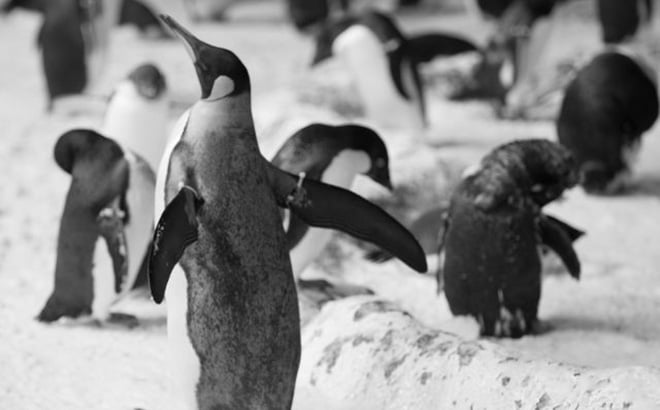
There are 18 species of penguin, and they all live around temperate and subantarctic islands in the Southern Hemisphere. Penguins are most commonly known for living in the frigid climate of Antarctica. However, they can be found in a number of different places such as: Tierra del Fuego, South Georgia (the country, not the state!), South Sandwich Islands, South Orkneys, South Shetland, Bouvet, Peter Islands, Falkland, Kerguelen, Southern Australia, New Zealand, Chatham Islands, Tasmania, New Zealand and even Chile. The only penguin that lives north of the equator is the Galapagos penguin, which lives, you guessed it, on the Galapagos Islands.
Our SeaWorld Penguins
We have 6 out of the 18 species of penguins here at SeaWorld Orlando, each with their own unique characteristics. The Chinstrap Penguins have a thin, black line under their chins, while the Rockhopper Penguins sport spiky hairdos. The King Penguins are tall and stately; the Adelie are small and feisty. The Gentoo Penguins have a single white stripe on the tops of their heads, while the Magallenic have a single white stripe across their chests.
Pretty Warm Penguins
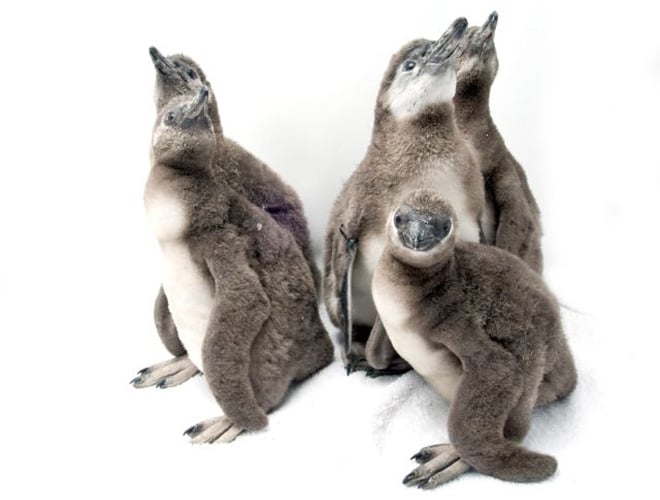
Keeping warm is a way of life for the penguins that live in freezing temperatures, so they have developed a number of ways to do so. Penguins have thick skin with lots of blubber underneath to keep them insulated in the cold weather, and they are known to huddle together and generate body heat. The dark color on their feathers help absorb the heat from the sun. Their feathers also tighten and overlap, which provides waterproofing and much-needed warmth.
What Do Penguins Eat?
Penguins enjoy an all-seafood diet, which includes fish, squid, krill and crustaceans. Penguins’ bills have a hook at the end, which helps them grab their food and their tongues have bristles that keep their food from escaping their mouths. Perhaps the most interesting part of their diet is their ability to drink salt water. Since they live far from fresh water, penguins have a gland located just above the eyes that filters out the salt and pushes it out of the grooves on their bill.
All Shapes and Sizes
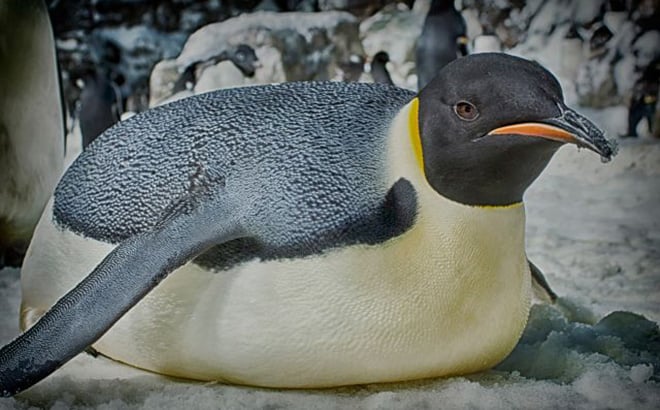
The largest of the penguins is the Emperor Penguin, standing at 3.7 ft. and weighing up to 90 lb. The smallest of penguins, cleverly named the Little Penguin, stands only 14-18 inches tall and weighs only 2.2 lbs. Despite these differences, all penguins’ bodies are adapted for swimming. Although they may not fly in the air, while underwater, their bodies are streamlined and perfectly adapted for “flying” underwater.
Don't Call Them a Flock
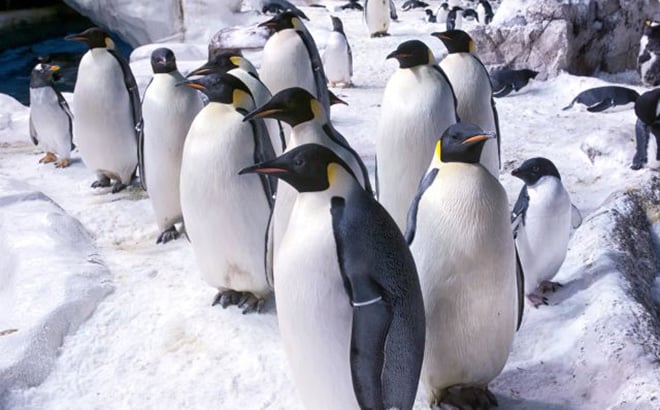
Here’s something too adorable to be false: a group of penguins swimming in the water is called a “raft.” On land, a group of penguins are referred to as a “waddle.” If there are any animal group names more fitting than “waddle” or “raft,” we’ve yet to find them.
Baby Penguins
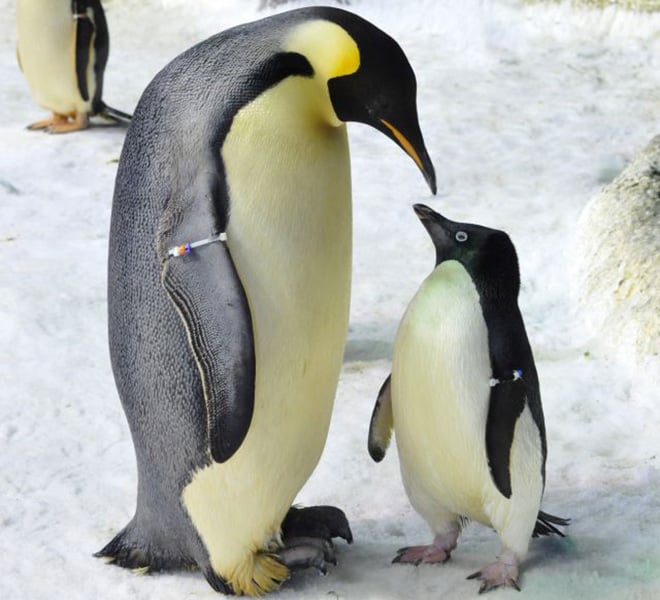
The teeny-tiny baby penguins are called “chicks” or “nestlings.” When penguin chicks are hatching, they will poke a small hole in their egg and they’ll keep chipping away at it until they can push themselves through, sometimes taking up to three days.
Now that you’re an amateur penguin expert, schedule time for some penguin research with a Penguins Up-Close tour at SeaWorld Orlando. When spending quality time with our penguins you’ll come to find there’s far more to them than black and white.
Where Do Penguins Live?

There are 18 species of penguin, and they all live around temperate and subantarctic islands in the Southern Hemisphere. Penguins are most commonly known for living in the frigid climate of Antarctica. However, they can be found in a number of different places such as: Tierra del Fuego, South Georgia (the country, not the state!), South Sandwich Islands, South Orkneys, South Shetland, Bouvet, Peter Islands, Falkland, Kerguelen, Southern Australia, New Zealand, Chatham Islands, Tasmania, New Zealand and even Chile. The only penguin that lives north of the equator is the Galapagos penguin, which lives, you guessed it, on the Galapagos Islands.
Our SeaWorld Penguins
We have 6 out of the 18 species of penguins here at SeaWorld Orlando, each with their own unique characteristics. The Chinstrap Penguins have a thin, black line under their chins, while the Rockhopper Penguins sport spiky hairdos. The King Penguins are tall and stately; the Adelie are small and feisty. The Gentoo Penguins have a single white stripe on the tops of their heads, while the Magallenic have a single white stripe across their chests.
Pretty Warm Penguins

Keeping warm is a way of life for the penguins that live in freezing temperatures, so they have developed a number of ways to do so. Penguins have thick skin with lots of blubber underneath to keep them insulated in the cold weather, and they are known to huddle together and generate body heat. The dark color on their feathers help absorb the heat from the sun. Their feathers also tighten and overlap, which provides waterproofing and much-needed warmth.
What Do Penguins Eat?
Penguins enjoy an all-seafood diet, which includes fish, squid, krill and crustaceans. Penguins’ bills have a hook at the end, which helps them grab their food and their tongues have bristles that keep their food from escaping their mouths. Perhaps the most interesting part of their diet is their ability to drink salt water. Since they live far from fresh water, penguins have a gland located just above the eyes that filters out the salt and pushes it out of the grooves on their bill.
All Shapes and Sizes

The largest of the penguins is the Emperor Penguin, standing at 3.7 ft. and weighing up to 90 lb. The smallest of penguins, cleverly named the Little Penguin, stands only 14-18 inches tall and weighs only 2.2 lbs. Despite these differences, all penguins’ bodies are adapted for swimming. Although they may not fly in the air, while underwater, their bodies are streamlined and perfectly adapted for “flying” underwater.
Don't Call Them a Flock

Here’s something too adorable to be false: a group of penguins swimming in the water is called a “raft.” On land, a group of penguins are referred to as a “waddle.” If there are any animal group names more fitting than “waddle” or “raft,” we’ve yet to find them.
Baby Penguins

The teeny-tiny baby penguins are called “chicks” or “nestlings.” When penguin chicks are hatching, they will poke a small hole in their egg and they’ll keep chipping away at it until they can push themselves through, sometimes taking up to three days.
Now that you’re an amateur penguin expert, schedule time for some penguin research with a Penguins Up-Close tour at SeaWorld Orlando. When spending quality time with our penguins you’ll come to find there’s far more to them than black and white.


